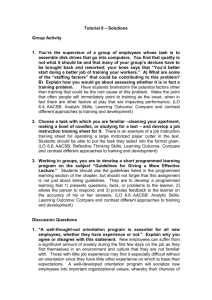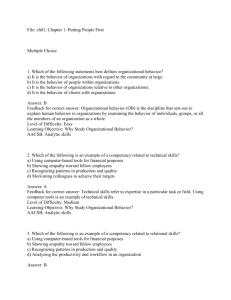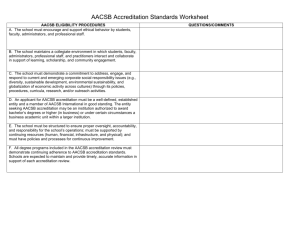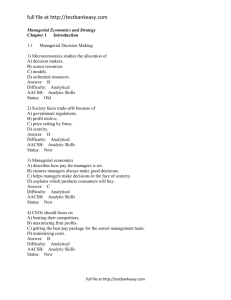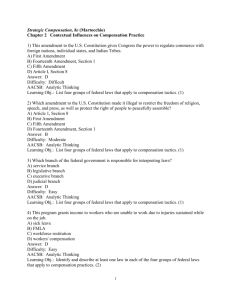T004-Solutions
advertisement
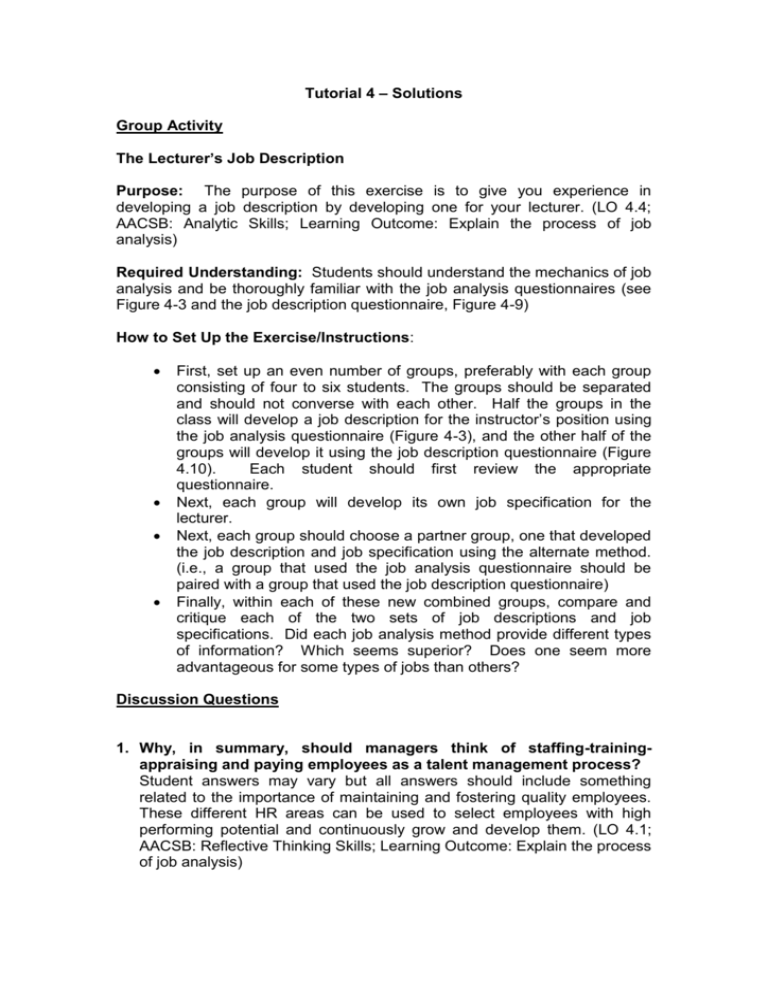
Tutorial 4 – Solutions Group Activity The Lecturer’s Job Description Purpose: The purpose of this exercise is to give you experience in developing a job description by developing one for your lecturer. (LO 4.4; AACSB: Analytic Skills; Learning Outcome: Explain the process of job analysis) Required Understanding: Students should understand the mechanics of job analysis and be thoroughly familiar with the job analysis questionnaires (see Figure 4-3 and the job description questionnaire, Figure 4-9) How to Set Up the Exercise/Instructions: First, set up an even number of groups, preferably with each group consisting of four to six students. The groups should be separated and should not converse with each other. Half the groups in the class will develop a job description for the instructor’s position using the job analysis questionnaire (Figure 4-3), and the other half of the groups will develop it using the job description questionnaire (Figure 4.10). Each student should first review the appropriate questionnaire. Next, each group will develop its own job specification for the lecturer. Next, each group should choose a partner group, one that developed the job description and job specification using the alternate method. (i.e., a group that used the job analysis questionnaire should be paired with a group that used the job description questionnaire) Finally, within each of these new combined groups, compare and critique each of the two sets of job descriptions and job specifications. Did each job analysis method provide different types of information? Which seems superior? Does one seem more advantageous for some types of jobs than others? Discussion Questions 1. Why, in summary, should managers think of staffing-trainingappraising and paying employees as a talent management process? Student answers may vary but all answers should include something related to the importance of maintaining and fostering quality employees. These different HR areas can be used to select employees with high performing potential and continuously grow and develop them. (LO 4.1; AACSB: Reflective Thinking Skills; Learning Outcome: Explain the process of job analysis) 2. Explain to the head of a company how he or she could use the talent management approach to improve his or her company’s performance. The answers here will be similar to the previous question. The important thing to look for in student responses is a thorough understanding of the advantages of keeping employees happy and productive through quality selection, appraisal and development processes. (LO 4.1; AACSB: Communication Skills; Learning Outcome: Explain the process of job analysis) 3. What items are typically included in the job description? A job description is a written statement of what the jobholder actually does, how he or she does it, and under what conditions the job is performed. There is no standard format for writing job descriptions, but most descriptions include sections on: job identification job summary relationships, responsibilities, and duties authority of incumbent standards of performance working conditions job specifications (LO 4.3; AACSB: Reflective Thinking Skills; Learning Outcome: Explain the process of job analysis) 4. What is job analysis? How can you make use of the information it provides? Job analysis is the procedure through which you determine the duties and nature of jobs and the kinds of people who should be hired for them. You can utilize the information it provides to write job descriptions and job specifications, which are then used in recruitment and selection, compensation, performance appraisal, and training. (LO 4.2; AACSB: Reflective Thinking Skills; Learning Outcome: Explain the process of job analysis) 5. We discussed several methods for collecting job analysis data— questionnaires, the position analysis questionnaire, and so on. Compare and contrast these methods, explaining what each is useful for and listing the pros and cons of each. Interviews are probably the most widely used method of collecting information for job analysis. The interview allows the incumbent to report activities that might not otherwise come to light (mental activities and activities that occur only occasionally). Observation is useful for jobs that consist mainly of physical activity that is clearly observable. Questionnaires are a quick and efficient way of obtaining information from a large number of employees; however, development costs can be high. Participant diary/logs can provide a comprehensive picture of a job, especially when supplemented with interviews; however, many employees do not respond well to the request to record all their daily activities. Quantitative job analysis techniques, such as PAQ, DOL, and Functional Job Analysis, are more appropriate when the aim is to assign a quantitative value to each job so that jobs can be compared for pay purposes. (LO 4.3; AACSB: Analytic Skills; Learning Outcome: Explain the process of job analysis) 6. Describe the types of information typically found in a job specification. It should include a list of the human traits and experience needed to perform the job. These might include education, skills, behaviors, personality traits, work experience, sensory skills, etc. (LO 4.5; AACSB: Communication Skills; Learning Outcome: Explain the process of job analysis) 7. Explain how you would conduct a job analysis. There are six major steps in a well-conducted job analysis: 1) Determine how the job analysis information will be used and how to collect the necessary information; 2) Collect background information such as organization charts, process charts, and job descriptions; 3) Select representative positions to be analyzed; 4) Collect job analysis information; 5) Review the information with the participants; 6) Develop job descriptions and job specifications. (LO 4.2; AACSB: Communication Skills; Learning Outcome: Explain the process of job analysis) 8. Do you think companies can really do without detailed job descriptions? Why or why not? Either side is an acceptable position to take. The key to grading this answer is the quality of the “why or why not” explanations. Look for students to clearly explain their position in terms of the effects of the lack of job descriptions on the performance, motivation, and capabilities of the people doing the job. In light of the Americans with Disabilities Act, discussions should also touch upon how an organization can adequately identify the “essential functions” of jobs without job descriptions. (LO 4.4; AACSB: Analytic Skills; Learning Outcome: Explain the process of job analysis) 9. In a company with only 25 employees, is there less need for job descriptions? Why or why not? It is clearly more difficult to write job descriptions for positions that may have broad responsibilities because of the organization’s size. This does not, however, mean that it is less important. Look for sound arguments and reasoning. Again, the ADA applies to companies with as few as 15 employees. What other ways can a small employer successfully document the “essential functions” of a job? (LO 4.4; AACSB: Analytic Skills; Learning Outcome: Explain the process of job analysis)


